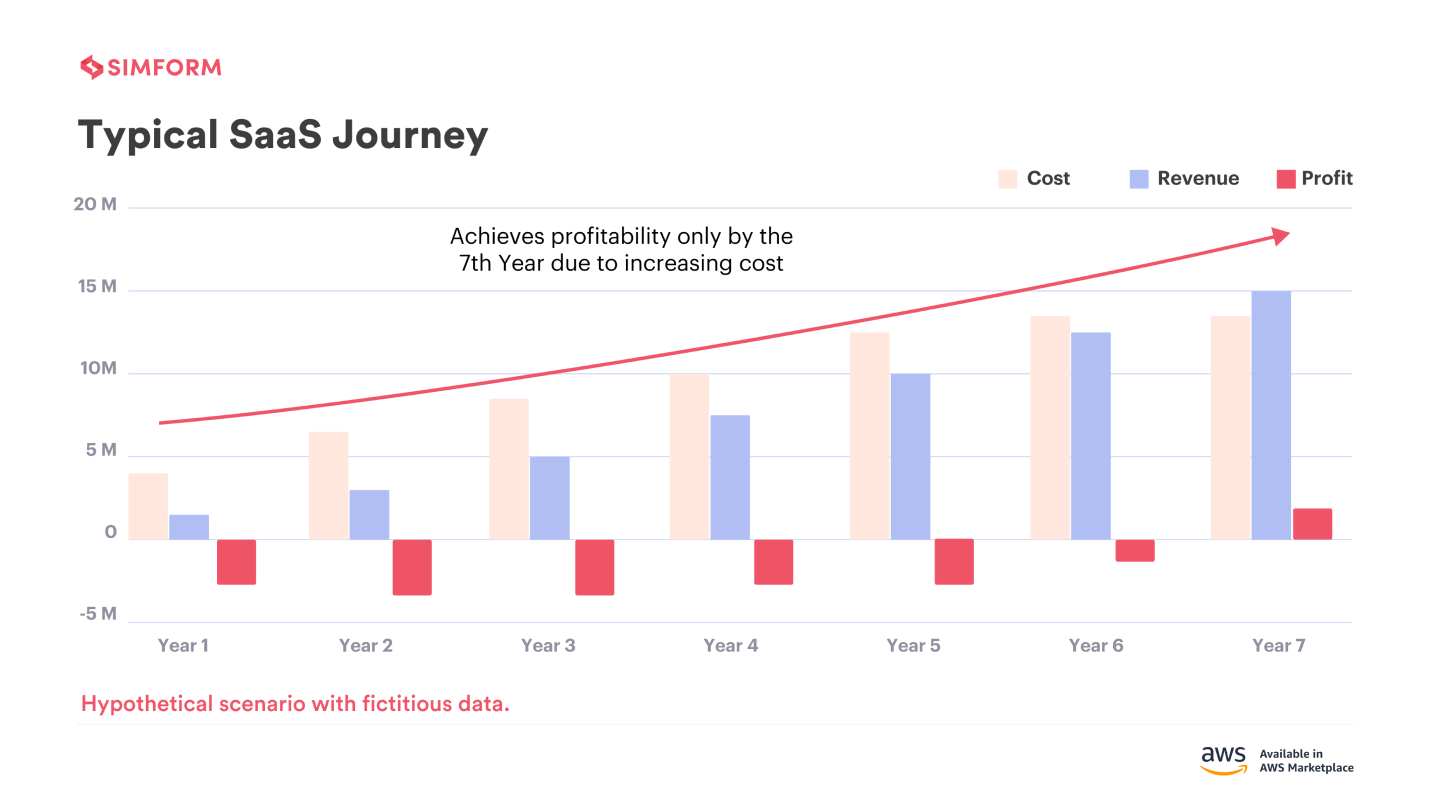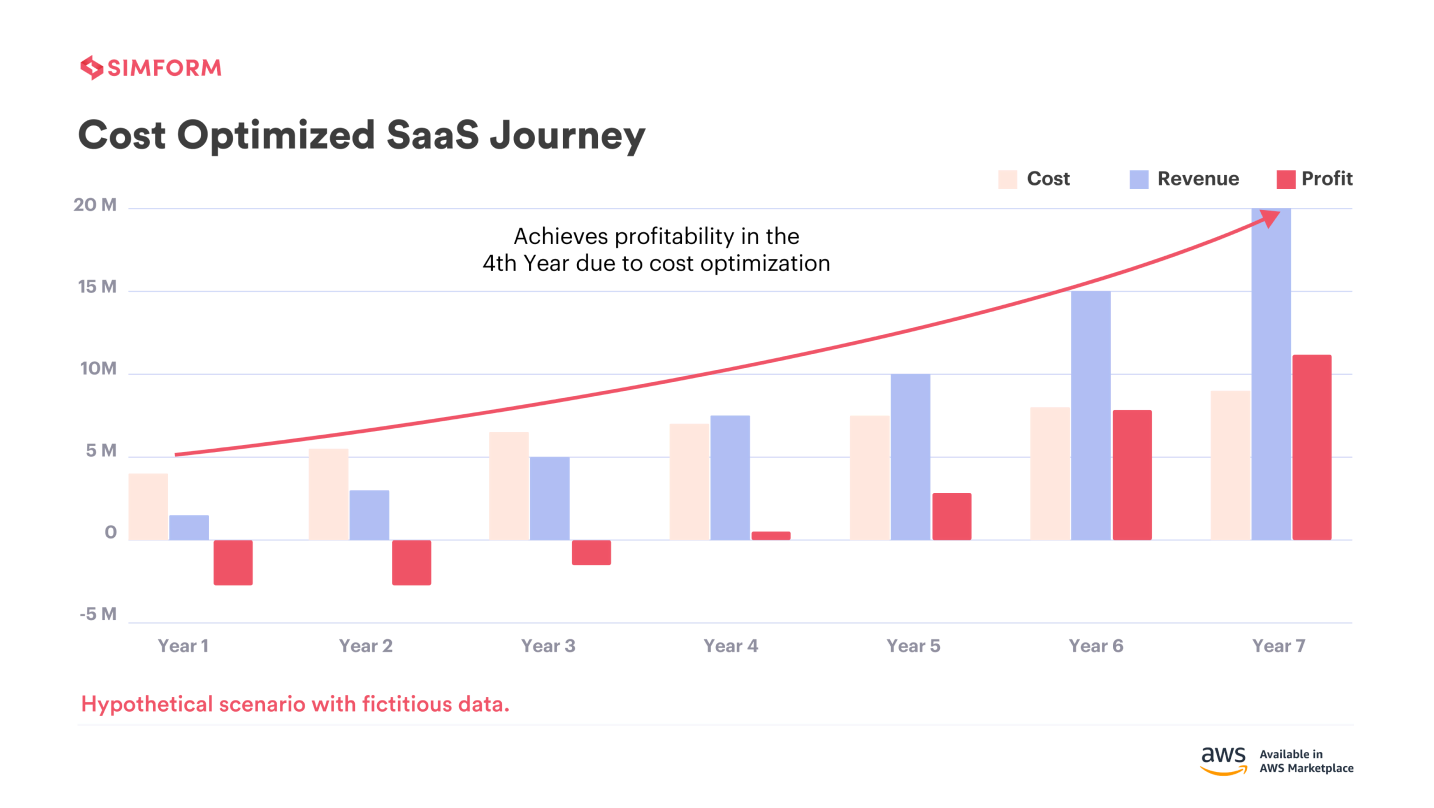Shopify, starting as a single-tenant application, soon migrated to multi-tenancy. And that’s how it was able to serve hundreds of thousands of merchants and handle thousands of requests per second, ultimately becoming one of the largest e-commerce platforms. Other leading brands like Slack, Salesforce, and Zendesk also utilize multi-tenant architecture to effectively cater to multiple organizations.
Software as a service has indeed become a hugely popular business model for developing web and mobile applications. And multitenancy, a single instance of software serving multiple clients, is a key enabler for efficient resource sharing and scalability within this model.
However, SaaS applications can be costly to maintain and scale for multiple tenants despite the promised flexibility. Though multi-tenancy saves costs, it can create challenges with infrastructure management while also adding to the complexity and security risks of the application.
To address these challenges, AWS supports SaaS applications with its scalable, secure services that enhance efficiency and user satisfaction. This article sheds light on the cost-saving aspect of multi-tenant SaaS applications, exploring the significant role of AWS SaaS Factory through insightful real-life case studies.
AWS SaaS Factory: The power of 3 pillars
The AWS SaaS Factory is designed to help businesses build, deliver, and optimize SaaS solutions on AWS. It offers prescriptive guidance, resources, and support so that organizations can successfully adopt a SaaS delivery model, migrate their existing solutions to AWS, or enhance their SaaS offerings.
There are three main pillars driving AWS SaaS Factory’s mission:
1. Boost your SaaS knowledge:
- The program is designed to educate and enable both partners and AWS customers on both technical and business-related aspects of the SaaS journey.
- It offers various forms of informative content, including 150+ best practice resources, training material, case studies, and more.
- This content can be found on the AWS SaaS Factory Insights Hub and AWS SaaS Insights, and is also available via email.
2. Leverage ready-to-use resources:
Typical SaaS vs cost-optimized SaaS: A journey worth taking
Providing clients with software solutions that can be conveniently accessed and used via web browsers on a subscription basis, the SaaS industry, of course, is booming.
Although some SaaS companies may experience rapid growth and profitability through innovative products, this is not the usual path for most businesses in this sector. And despite the widespread popularity and market dominance, some applications may not turn a profit, as is the case with Uber.
However, on average, it takes a SaaS company around 7-10 years to truly hit its stride and have substantial financial rewards.

This timeline can be attributed to a range of factors, including a steep learning curve, trial-and-error approaches to product development, and navigating the competitive landscape.
In a multi-tenant SaaS application, customers enjoy lower costs for the software, storage, and subscription services, as well as minimal maintenance and infrastructure responsibilities. However, balancing costs and providing efficient and secure services can become complex, particularly regarding performance, security, scalability, and innovation.
One of the main challenges SaaS companies encounter is the extensive list of costs involved in developing, marketing, and maintaining their products.
Visible costs include cloud infrastructure, development and maintenance, marketing and sales, overheads, and third-party services.
But again, hidden costs can quickly accumulate and eat into potential profitability, such as scaling challenges, data storage costs, downtime and service outages, compliance and security costs, R&D investment, and technical debt.
Through cost optimization and focused growth strategies, many SaaS applications can begin to see promising financial results within four years, although reaching their full potential may still take much longer.

We’ll soon see how SaaS companies can shift from a cash-burning model to a cash-generating one!
Multi-tenant architecture for a SaaS application
At its core, multi-tenancy refers to the architecture in which a single instance or deployment of a software application serves multiple customers, known as tenants.
Each tenant can access and manage their data separately using the same application infrastructure. This architecture is especially beneficial for cloud-based applications, as it allows for easy resource allocation, streamlined maintenance, and optimized performance across different customers.
But to successfully implement a multi-tenant SaaS application, businesses should prioritize the following cost optimization strategies:
- Right-size resources: Select the appropriate instance type, size, and number for the application based on its specific requirements, such as computing power, memory, or storage.
- Increase elasticity: Leverage various cloud services, such as auto-scaling groups, to adjust resources based on real-time demand automatically.
- Leverage the right pricing model: Select between on-demand, reserved instances, spot instances, and savings plans, depending on the nature of the application.
- Optimize storage: Use a range of storage classes, such as hot, cool, or archive tiers, based on how frequently the data is accessed or how long it needs to be stored.
Real-world examples of cost-optimized multi-tenant SaaS applications
Let’s see some real-world examples that show how cost optimization can be achieved for multi-tenant SaaS applications.
Boosting tenant experience with strategic optimization
An auction service vendor sought to optimize its multi-tenant SaaS solution by enhancing isolation and implementing cost optimization best practices. Simform helped them achieve isolation through a mix of pooled and siloed systems, using schema-based isolation on databases and persona-based customization.
The solution also introduced separate environments for demo and trial users, automating the creation and deletion process through infrastructure as code. The migration to Kubernetes resulted in a 20% efficiency increase, allowing for 30% more workloads at the same cost.
Improving compliance isolation with the right cost-security balance
An e-commerce marketplace sought a balance between cost and security while adhering to PCI, SOC 2, and GDPR compliance standards. Strategies we employed included AWS Security Hub for monitoring compliance and optimizing costs with AWS resource groups.
By identifying areas for improvement through well-architected reviews (WARs), we helped them upgrade instances to reduce costs and improve performance. Additionally, we implemented automated ticket management systems to streamline their security response process.
Successfully transitioning Tech Connect Solutions: From on-prem to cloud
A company operating a multi-tenant SaaS application aimed to simplify optimization by understanding tenant requirements and sought guidance in transitioning from their on-prem infrastructure to utilizing AWS for cost reduction. Simform helped them identify KPIs, prioritize workloads based on criticality, and implement cost-saving measures like auto-scaling. Furthermore, the High Availability (HA) configurations were established to maintain service continuity for mission-critical components, and disaster recovery strategies were developed accordingly.
By continuously monitoring and measuring KPIs, the company can optimize their AWS usage on a per-tenant basis, ensuring they meet SLAs and maintain cost efficiency. With the right balance between cost and service quality, the company found value in strategically leveraging AWS’s multi-region support, high availability features, and various optimization methods.
Multi-tenant SaaS applications are the next step
Optimizing the cost of multi-tenant SaaS applications is an important process that drives efficiency and innovation in the competitive SaaS market. Ensuring high performance, making data-driven decisions with metrics and analytics, and continuously optimizing the system from the beginning are necessary elements in achieving this goal. Moreover, benchmarking allows for right-sizing applications, ensuring tenancy requirements are met.
To effectively optimize your multi-tenant SaaS applications, it is essential to partner with a company experienced in implementing the best practices and advanced tools. Simform, an AWS premier consulting partner, is dedicated to bringing you industry-leading expertise that guarantees uncompromised performance and cost-efficiency in your multi-tenant SaaS applications.